

War Poetry: Ted Hughes: 'Bayonet Charge' I have already said my piece about the AQA GCSE poetry syllabus and what it calls the 'Conflict' cluster.
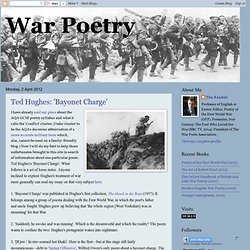
(I take 'cluster' to be the AQA's decorous abbreviation of a more accurate military term which, alas, cannot be used on a family-friendly blog.) Now I will do my best to help those unfortunates brought to this site in search of information about one particular poem: Ted Hughes's 'Bayonet Charge'. What follows is a set of loose notes. Anyone inclined to explore Hughes's treatment of war more generally can read my essay on that very subject here. 1. 2. 3. 4. 5. 6. 7. 8. 9. 10. 11. 12. Hughes wrote far better poems than 'Bayonet Charge'. Postscript: for an account of Jane Weir's 'Poppies', see here. A global guide to the first world war - interactive documentary. Gallipoli and the Anzacs - Australia. Recreating Gallipoli in Minecraft. As part of our centenary education programme, Auckland Museum is making use of the popular Minecraft® game to engage students with the events that occurred at Gallipoli in 1915.

Minecraft® is an award-winning game that encourages creativity and adventure. It allows game players to break and place blocks working together to create virtual structures, landscapes, and worlds. 2014 saw Auckland Museum team up with Media Design School, Alfriston College and some select Minecraft builders to recreate Gallipoli as it was during the First World War. First World War - NZ. WWI Battlefields. WW100 New Zealand. A selection of sites and sources for learning about the history of the First World War from a New Zealand perspective, and the role your family members might have played in it.
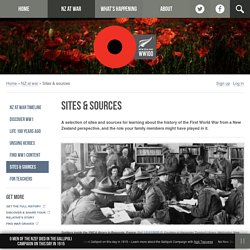
Soldiers inside the YMCA library in Beauvois, France. Ref: 1/2-013635-G. Courtesy of Alexander Turnbull Library, Wellington, New Zealand. Starting Places Use these websites to start your learning journey. Passchendaele Society. The Gallipoli campaign. Each year on Anzac Day, New Zealanders (and Australians) mark the anniversary of the Gallipoli landings of 25 April 1915.
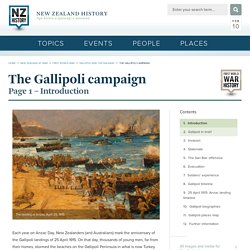
On that day, thousands of young men, far from their homes, stormed the beaches on the Gallipoli Peninsula in what is now Turkey. For eight long months, New Zealand troops, alongside those from Australia, Great Britain and Ireland, France, India, and Newfoundland battled harsh conditions and Ottoman forces desperately fighting to protect their homeland. By the time the campaign ended, more than 130,000 men had died: at least 87,000 Ottoman soldiers and 44,000 Allied soldiers, including more than 8700 Australians. Battle of Gallipoli - World War I. With World War I stalled on the Western Front by 1915, the Allied Powers were debating going on the offensive in another region of the conflict, rather than continuing with attacks in Belgium and France.
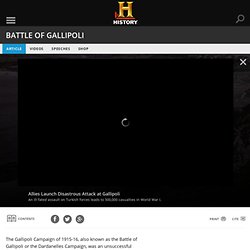
Early that year, Russia’s Grand Duke Nicholas appealed to Britain for aid in confronting a Turkish invasion in the Caucasus. (The Ottoman Empire had entered World War I on the side of the Central Powers, Germany and Austria-Hungary, by November 1914.) In response, the Allies decided to launch a naval expedition to seize the Dardanelles Straits, a narrow passage connecting the Aegean Sea to the Sea of Marmara in northwestern Turkey. WW1 Battlefields of the Western Front. The long line of battlefields that makes up the Western Front runs through a wide variety of landscapes in south-west Belgium, north-eastern and eastern France.
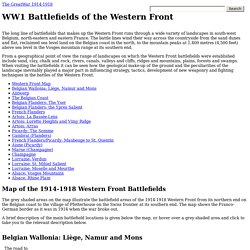
The battle lines wind their way across the countryside from the sand dunes and flat, reclaimed sea level land on the Belgian coast in the north, to the mountain peaks at 1,400 metres (4,500 feet) above sea level in the Vosges mountain range at its southern end. BBC Schools - Life in the trenches. 31 October 2014Last updated at 15:07 Two British soldiers standing in a flooded communication trench during World War One On the Western Front, the war was fought in trenches. Trenches were long, narrow ditches dug into the ground where soldiers lived all day and night. There were many lines of German trenches on one side and many lines of Allied trenches on the other. In the middle, was no man's land, so-called because it did not belong to either army.
WORLD WAR ONE TRENCH WARFARE. First World War. Origins The First World War was caused by the destabilisation of the balance of power in Europe due to the rise of Germany.
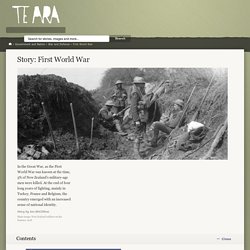
The war began in 1914 when Austria-Hungary invaded Serbia because of the assassination of an archduke. Countries had made alliances with each other, and soon most of Europe was at war.